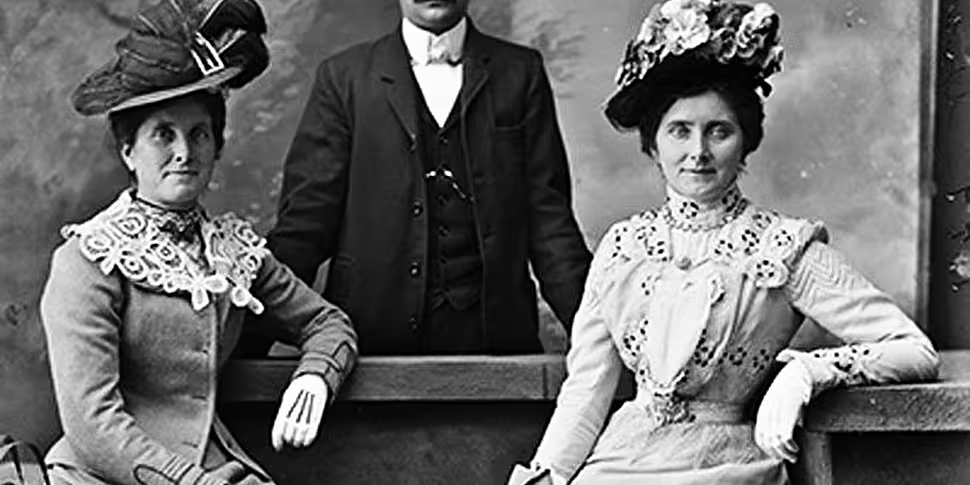The Central Statistics Office (CSO) is marking the centenary of the 1916 Rising, by releasing and comparing figures from that time to today.
The CSO say they wanted to illustrate what life was like for people living 100 years ago.
The office found a range of statistics - including population, births, marriages, deaths, education, crime, prices, transport and agriculture.
Among the findings was that the population of Ireland increased by 46% in the 100 years between 1911 and 2011, from 3.1 million to 4.6 million people.
Today in Ireland, there are fewer young people and more middle-aged people compared with Ireland in 1911.
There is also much more variety today in names for baby boys and girls compared with over 100 years ago.
A young girl pushes two infants in a perambulator in 1904 | Image: CSO
While Irish names for babies - such as Aoife or Oisín - were rare in 1911, they are now very popular.
Dublin was a city of extremes in housing in 1911 - when 22% of dwellings were large homes and 36% were one room tenements.
Nearly half of workers were in agriculture, in comparison to just 5% today.
One in ten workers in 1911 worked as a domestic servant, compared to only a few thousand people in 2011.
The rate of illiteracy in Ireland was 8.3% in 1911, and varied widely across the country - with the lowest rate in Dublin and the highest rates in Donegal, Galway, Mayo and Waterford.
Close to 10% of the population was protestant in Ireland in 1911 - but by 2011 this had dropped to 3.6%.
Less than one-fifth of the population could speak Irish in 1911 - and this had increased to two-fifths by 2011.
Source: CSO
Just 2.4% of births in 1916 were outside marriage but by 2012, over one-third were outside marriage - with rates of over 40% in Dublin city, Waterford, Louth and Wexford.
The infant mortality rate was 81.3 in Ireland in 1916 - meaning for every 1,000 babies born during 1916, 81 died before they reached 12 months.
The highest rate was in Dublin city at 153.5, and the lowest rate was in Roscommon at 34.6.
By 2014 the infant mortality rate in Ireland was very low, at 3.7 per 1,000 births.
Lady Waterford and baby, circa 1900-1910 | Image: CSO
Life expectancy has risen strongly since 1911 for all age groups - with the greatest increases for younger age groups.
A baby boy born in 2011 can expect to live for nearly 25 more years than a baby boy born in 1911, with life expectancy at birth increasing for males from 53.6 years to 78.3 years between 1911 and 2011.
A baby girl born in 2011 can expect to have an extra 28.6 years of life compared to a girl born in 1911, with life expectancy at birth increasing for females from 54.1 years to 82.7 years.
Economy and transport
The 32 county economy of Ireland was dominated in 1916 by four industries: agriculture, linen production, shipbuilding and brewing and distilling.
The first three of these were positively impacted by the war - with increased demand for food, linen and ships directly linked to the war effort.
The government spent £11.5m on the island of Ireland in 1911 and raised £10.7m revenue, giving a deficit of about £0.8m.
Mr Meardon and a group in motor cars at Bonmahon Mines in 1906 | Image: CSO
By 1916, the overall fiscal situation in Ireland was very favourable for the British government. Nearly £24m was raised in Ireland but just over half of this - £12.6m - was spent in Ireland, giving a surplus of over £11m towards the war effort in Britain.
While in 1915, there were 9,850 cars in Ireland and 7,580 motorcycles. By 2014, there were 1.9 million private cars and 36,573 motorcycles.
Ships were the only method of transporting people and goods to and from the island of Ireland to the outside world in 1916.
In 1911 there were more than 80 cross-channel sailings per week to Britain from Dublin Port.
The ports on the island of Ireland in 1913 handled 26.5 million tonnes of goods - and this compares with 47.5 million tonnes of goods handled in 2014.














